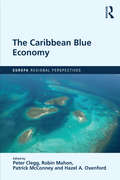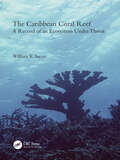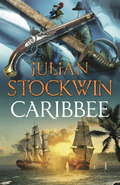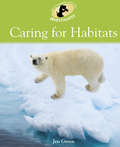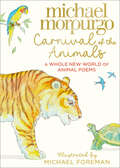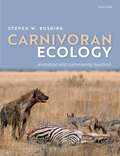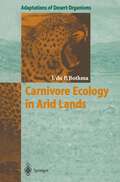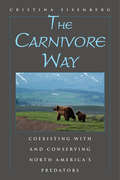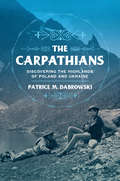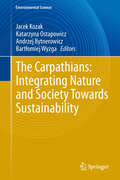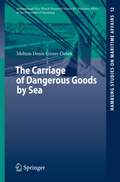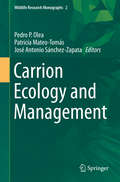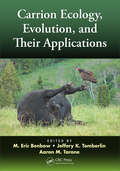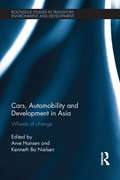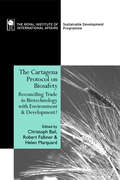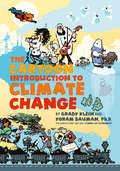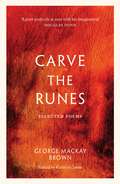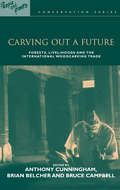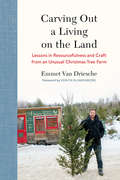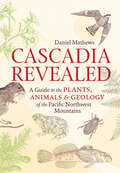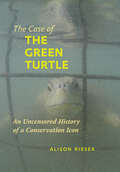- Table View
- List View
The Caribbean Blue Economy (Europa Regional Perspectives)
by Peter Clegg, Robin Mahon, Patrick McConney and Hazel A. OxenfordThe Blue Economy is emerging on the global scene as a powerful and persuasive new concept for sustainable development based on economic activities associated with the ocean. Several regions globally have adopted this concept at national and regional levels, including the Caribbean. Given the complex, multisectoral and multilevel nature of the Blue Economy, it is clear that different approaches will be needed for different regions. Hence, this volume explores the opportunities, threats and risks involved in operationalising the Blue Economy in the Wider Caribbean Region, defined as northern Brazil to the USA and all mainland and island countries and territories in-between. The first part of the book looks at where the region stands in the global picture regarding adoption of the Blue Economy and what is planned. The second set of chapters examines key crosscutting issues such as ecosystem services, climate change and governance at national and regional levels that could make or break the Blue Economy initiative. The book then goes on to explore the main sectoral activities that will constitute the Blue Economies in the region: fisheries, tourism, shipping and transport, renewable energy, oil and gas, seabed mining and waste management are all considered. The book ends with a synthesis of the political and technical requirements to overcome threats and take advantage of opportunities in the Blue Economy.
The Caribbean Coral Reef: A Record of an Ecosystem Under Threat
by William K. SaccoThis book is a visual tour of Caribbean coral reefs between 1968 and 1978. They are the world’s second largest coral reef community and the most threatened. The Caribbean Coral Reef: A Record of an Ecosystem Under Threat offers a priceless historical record made by a photographer who set out to document the major reef species when those reefs were at their prime. Today, coral reefs are under threat as never before and, sadly, most of what is shown in the book's photographs is now gone forever. It is only by comparing the images in this book with what we see now that we are able to fully recognize what we have lost. With its stunning photography and precise, accurate scientific information, this book offers students of coral reefs a wealth of information about this rich, fragile ecosystem. It is also written accessibly for non-academic visitors to the Caribbean reef or anyone interested in the earth’s creatures. Many of the invertebrates will be unfamiliar to most people, and the author reveals fascinating insights into these otherworldly creatures and their lifestyles. Enjoy this field guide to the reefs that were, and savor the beauty of this vanishing environment and its organisms.
The Caribbean Coral Reef: A Record of an Ecosystem Under Threat
by William K. SaccoThis book is a visual tour of Caribbean coral reefs between 1968 and 1978. They are the world’s second largest coral reef community and the most threatened. The Caribbean Coral Reef: A Record of an Ecosystem Under Threat offers a priceless historical record made by a photographer who set out to document the major reef species when those reefs were at their prime. Today, coral reefs are under threat as never before and, sadly, most of what is shown in the book's photographs is now gone forever. It is only by comparing the images in this book with what we see now that we are able to fully recognize what we have lost. With its stunning photography and precise, accurate scientific information, this book offers students of coral reefs a wealth of information about this rich, fragile ecosystem. It is also written accessibly for non-academic visitors to the Caribbean reef or anyone interested in the earth’s creatures. Many of the invertebrates will be unfamiliar to most people, and the author reveals fascinating insights into these otherworldly creatures and their lifestyles. Enjoy this field guide to the reefs that were, and savor the beauty of this vanishing environment and its organisms.
Caribbee: Thomas Kydd 14 (Thomas Kydd #14)
by Julian Stockwin'In Stockwin's hands the sea story will continue to entrance readers across the world' - GuardianMore than a decade ago, Thomas Kydd and Nicholas Renzi were in the Caribbean as sailors before the mast in the old Trajan. Now Kydd, a storied hero of Trafalgar, holds the glory of being post-captain of the 32-gun frigate, L'Aurore. After unremitting war a Caribbean posting seems a welcome respite. But Kydd and Renzi soon find themselves facing a familiar threat as the French imperil Britain's vital sugar trade.When merchantmen begin vanishing from the sea, Kydd and Renzi must embark on a dangerous game of espionage, seamanship and breath-taking action in order to destroy a new and terrible danger to the Empire.*********************What readers are saying about CARIBBEE'A proper swashbuckling affair' - 5 stars'Totally amazing!' - 5 stars'Loved this book' - 5 stars'A real find' - 5 stars'A gripping read' - 5 stars
Caring For Habitats: Caring For Habitats (library Ebook (Environment Detective Investigates #2)
by Jen GreenWhat is a habitat?Why are habitats under threat?How can we help to take care of habitats?The Environment Detective Investigates helps you to answer these questions and many more about habitats. Find out about the different habitats on Earth, what harm pollution is doing to habitats and why they need our protection.
Carnival of the Animals
by Michael MorpurgoA stunning gift collection of animal poems from master storyteller Michael Morpurgo, celebrating with heart and humour the creatures with whom we share our planet.
Carnivoran Ecology: The Evolution and Function of Communities
by Steven W. BuskirkThese charismatic mammals, which include dogs, cats, hyenas, weasels, mongooses, seals, sea lions and bears, have always held special importance to humans throughout history and continue to do so today. In recent decades, the emergence of new technologies has completely transformed our knowledge of how carnivorans interact with their environments and consequently reshaped our view of carnivoran ecology. This unique synthesis uses examples from a diverse and expanding carnivoran literature, drawing from all carnivoran families and spanning the world's oceans and continents, to produce a clearly written and richly illustrated book that reviews our current state of knowledge of carnivoran ecology. It addresses all levels of biological organization and function, from genes to enzymes, organisms, populations, and ecosystems. Special attention is given to how carnivoran species interact with their prey, each other, and humans. There is an emphasis on community interactions and their importance in carnivoran evolution, showing how evolutionary constraints (morphological, physiological, and behavioral) structure communities today. The book's approach is strongly comparative, contrasting herbivores with carnivores, predators with scavengers, and cats with dogs. Carnivorans play important roles in many high-profile conservation cases, either as species of concern or agents of endangerment, and their importance is demonstrated in both contexts. Carnivoran Ecology is an accessible advanced textbook aimed principally at senior undergraduate and graduate students taking courses in carnivore ecology, as well as a broad audience of professional academics (especially carnivore and mammalian biologists), researchers, and practitioners working in both governmental and non-governmental organizations. A significant secondary market will exist amongst the large amateur naturalist community including those wishing to explore the ecological and evolutionary links between domestic carnivorans (dogs, cats, ferrets etc.) and their wild counterparts.
Carnivore Ecology in Arid Lands (Adaptations of Desert Organisms)
by Jacobus du BothmaArid lands require that organisms inhabiting them be well-adapted to thrive or even just to survive. This book provides a review of the ecological adaptations - be they behavioural, physiological or morphological - of carnivores to arid environments. Following a general introduction into aridity and arid lands in Africa, the major carnivore families are presented. Ecological adaptations of carnivores in arid lands reveal the amplitude and resilience of the ecology of these animals. In setting up conservation measures, the nature and extent of such adaptations are important facets in determining the effective area and degree of heterogeneity required as habitat by a carnivore population so as to produce a viable unit.
The Carnivore Way: Coexisting with and Conserving North America's Predators
by Cristina EisenbergWhat would it be like to live in a world with no predators roaming our landscapes? Would their elimination, which humans have sought with ever greater urgency in recent times, bring about a pastoral, peaceful human civilization? Or in fact is their existence critical to our own, and do we need to be doing more to assure their health and the health of the landscapes they need to thrive? In The Carnivore Way, Cristina Eisenberg argues compellingly for the necessity of top predators in large, undisturbed landscapes, and how a continental-long corridor—a “carnivore way”—provides the room they need to roam and connected landscapes that allow them to disperse. Eisenberg follows the footsteps of six large carnivores—wolves, grizzly bears, lynx, jaguars, wolverines, and cougars—on a 7,500-mile wildlife corridor from Alaska to Mexico along the Rocky Mountains. Backed by robust science, she shows how their well-being is a critical factor in sustaining healthy landscapes and how it is possible for humans and large carnivores to coexist peacefully and even to thrive.University students in natural resource science programs, resource managers, conservation organizations, and anyone curious about carnivore ecology and management in a changing world will find a thoughtful guide to large carnivore conservation that dispels long-held myths about their ecology and contributions to healthy, resilient landscapes.
The Carpathians: Discovering the Highlands of Poland and Ukraine (NIU Series in Slavic, East European, and Eurasian Studies)
by Patrice M. DabrowskiIn The Carpathians, Patrice M. Dabrowski narrates how three highland ranges of the mountain system found in present-day Poland, Slovakia, and Ukraine were discovered for a broader regional public. This is a story of how the Tatras, Eastern Carpathians, and Bieszczady Mountains went from being terra incognita to becoming the popular tourist destinations they are today. It is a story of the encounter of Polish and Ukrainian lowlanders with the wild, sublime highlands and with the indigenous highlanders—Górale, Hutsuls, Boikos, and Lemkos—and how these peoples were incorporated into a national narrative as the territories were transformed into a native/national landscape.The set of microhistories in this book occur from about 1860 to 1980, a time in which nations and states concerned themselves with the "frontier at the edge." Discoverers not only became enthralled with what were perceived as their own highlands but also availed themselves of the mountains as places to work out answers to the burning questions of the day. Each discovery led to a surge in mountain tourism and interest in the mountains and their indigenous highlanders.Although these mountains, essentially a continuation of the Alps, are Central and Eastern Europe's most prominent physical feature, politically they are peripheral. The Carpathians is the first book to deal with the northern slopes in such a way, showing how these discoveries had a direct impact on the various nation-building, state-building, and modernization projects. Dabrowski's history incorporates a unique blend of environmental history, borderlands studies, and the history of tourism and leisure.
The Carpathians: Integrating Nature and Society Towards Sustainability (Environmental Science and Engineering)
by Jacek Kozak, Katarzyna Ostapowicz, Andrzej Bytnerowicz and Bartłomiej WyżgaThe book includes a broad spectrum of perspectives from different scientific disciplines (both the natural and social sciences) as well as practical knowledge. It gives a new insight into the Carpathian mountain region
The Carriage of Dangerous Goods by Sea (Hamburg Studies on Maritime Affairs #12)
by Meltem Deniz Güner-ÖzbekEver-increasing numbers of dangerous goods are carried by sea today. Worldwide concern with the risk posed by this increased frequency has led to the adoption of international technical standards to promote maritime safety and the insertion of special provisions in the carriage contracts. Moreover, growing environmental awareness and concern with the economic cost implications of maritime casualties have given rise to the regulation of liability and compensation.
Carrion Ecology and Management (Wildlife Research Monographs #2)
by Pedro P. Olea Patricia Mateo-Tomás José Antonio Sánchez-ZapataCarrion, or dead animal matter, is an inherent component of aquatic and terrestrial ecosystems worldwide, and is exploited by a wide diversity of organisms from different trophic levels, including microbes, arthropods and vertebrates. Further, carrion consumption by scavengers, i.e. scavenging, supports key ecosystem functions and services such as recycling nutrients and energy, disposing of carcasses and regulating disease spread. Yet, unlike dead plant matter, dead animal decomposition has received little attention in the fields of ecology, wildlife conservation and environmental management, and as a result the management of carrion for maintaining biodiversity and functional ecosystems has been limited. This book addresses the main ecological patterns and processes relating to the generation and consumption of carrion both in terrestrial and aquatic ecosystems. It also discusses a number of conservation concerns and associated management issues, particularly regarding the increasing role of human-mediated carrion in ecosystems. Lastly, the book outlines future research lines in carrion ecology and management, and identifies the major challenges for scavengers and scavenging processes in the Anthropocene.
Carrion Ecology, Evolution, and Their Applications
by M. Eric Benbow Jeffery K. Tomberlin Aaron M. TaroneShortlisted for the 2018 TWS Wildlife Publication Awards in the edited book categoryDecomposition and recycling of vertebrate remains have been understudied, hampered largely due to these processes being aesthetically challenging (e.g., smell and sight). Technological innovations have provided the means to explore new and historically understo
Cars, Automobility and Development in Asia: Wheels of change (Routledge Studies in Transport, Environment and Development)
by Arve Hansen and Kenneth Bo NielsenCars, Automobility and Development in Asia explores the nexus between automobility and development in a pan-Asian comparative perspective. The book seeks to integrate the policies, production forms, consumption preferences and symbolism implicated in emerging Asian automobilities. Using empirically rich and grounded analyses of both comparative and single-country case studies, the authors chart new approaches to studying automobility and development in emerging Asia.
Cars, Automobility and Development in Asia: Wheels of change (Routledge Studies in Transport, Environment and Development)
by Arve Hansen Kenneth Bo NielsenCars, Automobility and Development in Asia explores the nexus between automobility and development in a pan-Asian comparative perspective. The book seeks to integrate the policies, production forms, consumption preferences and symbolism implicated in emerging Asian automobilities. Using empirically rich and grounded analyses of both comparative and single-country case studies, the authors chart new approaches to studying automobility and development in emerging Asia.
The Cartagena Protocol on Biosafety: Reconciling Trade in Biotechnology with Environment and Development
by Christoph Bail Robert Falkner Helen MarquardModern biotechnology - the controversial manipulation of genes in living organisms - has far-reaching implications for agriculture, human health, trade and the environment. Against the odds, an international treaty governing biosafety and trade in biotechnology was adopted in 2000. The Cartagena Protocol on Biosafety of the Convention on Biological Diversity deals with one of the most important and challenging issues thrown up by developments in biotechnology. This volume is a comprehensive review of the protocol and the process that led to its adoption. It includes contributions from many of the key players involved and analyses the commercial and political interests at stake, the operations and implications of the protocol, and prospects for the future.
The Cartoon Introduction to Climate Change
by Yoram Bauman Grady KleinClimate change is no laughing matter—but maybe it should be. The topic is so critical that everyone, from students to policy-makers to voters, needs a quick and easy guide to the basics. The Cartoon Introduction to Climate Change entertains as it educates, delivering a unique and enjoyable presentation of mind-blowing facts and critical concepts."Stand-up economist" Yoram Bauman and award-winning illustrator Grady Klein have created the funniest overview of climate science, predictions, and policy that you’ll ever read. You’ll giggle, but you’ll also learn—about everything from Milankovitch cycles to carbon taxes. If those subjects sound daunting, consider that Bauman and Klein have already written two enormously successful cartoon guides to economics, making the notoriously dismal science accessible to countless readers.If economics can be funny, then climate science can be a riot. The Cartoon Introduction to Climate Change takes the intimidation and gloom out of one of the most complex and hotly debated challenges of our time.
Carve the Runes: Selected Poems
by George Mackay BrownIn this, the first new selection of George Mackay Brown’s poetry for over 25 years, Kathleen Jamie explores the multi-faceted world of the poet’s Orkney, his lifelong home and inspiration.George Mackay Brown’s concerns were the ancestral world, the communalities of work, the fables and religious stories which he saw as underpinning mortal lives. Brown believed from the outset that poets had a social role and his true task was to fulfil that role. Art was sprung from the community, and his role as poet to know that community, to sing its stories.
Carving out a Future: "Forests, Livelihoods and the International Woodcarving Trade"
by Brian Belcher Bruce M Campbell Anthony CunninghamVery little has yet been written about the cultural or economic contributions of woodcarving to people's livelihoods or the consequences of felling hardwood and softwood trees for the international woodcarving trade. Carving Out a Future is the first examination of this trade and its critical links to rural livelihoods, biodiversity, conservation, forestry and the international trade regime. A range of case studies from Australia, Bali, India,Africa and Mexico provides a lens for examining the critical issues relating to the significant impacts of woodcarving on forests, conservation efforts, the need to promote sustainable rural livelihoods and efforts to promote trade so that skilled artisans in developing countries get a fair economic return. Livelihoods, Carving and Conservation * Global Overview * The Case of Woodcarving in Kenya * Drums and Hornbills * Sculpture and Identity * Carving Wood in Southern Zimbabwe * The Kiaat Woodcrafters of Bushbuckridge, South Africa * Carvers, Conservation and Certification in India * Colour, Sustainability and Market Sense in Bali * Aboriginal Woodcarvers in Australia * BurseraWoodcarving in Oaxaca, Mexico * Linaloe Wood Handicrafts * Learning from a Comparison of Cases * Carving, Sustainability and Scarcity * Certification of Woodcarving * Planning for Woodcarving in the 21st Century *
Carving out a Future: "Forests, Livelihoods and the International Woodcarving Trade"
by Brian Belcher Bruce M Campbell Anthony CunninghamVery little has yet been written about the cultural or economic contributions of woodcarving to people's livelihoods or the consequences of felling hardwood and softwood trees for the international woodcarving trade. Carving Out a Future is the first examination of this trade and its critical links to rural livelihoods, biodiversity, conservation, forestry and the international trade regime. A range of case studies from Australia, Bali, India,Africa and Mexico provides a lens for examining the critical issues relating to the significant impacts of woodcarving on forests, conservation efforts, the need to promote sustainable rural livelihoods and efforts to promote trade so that skilled artisans in developing countries get a fair economic return. Livelihoods, Carving and Conservation * Global Overview * The Case of Woodcarving in Kenya * Drums and Hornbills * Sculpture and Identity * Carving Wood in Southern Zimbabwe * The Kiaat Woodcrafters of Bushbuckridge, South Africa * Carvers, Conservation and Certification in India * Colour, Sustainability and Market Sense in Bali * Aboriginal Woodcarvers in Australia * BurseraWoodcarving in Oaxaca, Mexico * Linaloe Wood Handicrafts * Learning from a Comparison of Cases * Carving, Sustainability and Scarcity * Certification of Woodcarving * Planning for Woodcarving in the 21st Century *
Carving Out a Living on the Land: Lessons in Resourcefulness and Craft from an Unusual Christmas Tree Farm
by Emmet Van DriescheWhen he first envisioned becoming a farmer, author Emmet Van Driesche never imagined his main crop would be Christmas trees, nor that such a tree farm could be more of a managed forest than the conventional grid of perfectly sheared trees. Carving Out a Living on the Land tells the story of how Van Driesche navigated changing life circumstances, took advantage of unexpected opportunities, and leveraged new and old skills to piece together an economically viable living, while at the same time respecting the land’s complex ecological relationships. From spoon carving to scything, coppicing to wreath-making, Carving Out a Living on the Land proves that you don’t need acres of expensive bottomland to start your land-based venture, but rather the creativity and vision to see what might be done with that rocky section or ditch or patch of trees too small to log. You can lease instead of buy; build flexible, temporary structures rather than sink money into permanent ones; and take over an existing operation rather than start from scratch. What matters are your unique circumstances, talents, and interests, which when combined with what the land is capable of producing, can create a fulfilling and meaningful farming life.
Cascadia Revealed: A Guide to the Plants, Animals, and Geology of the Pacific Northwest Mountains
by Daniel MathewsCascadia Revealred is a must-have guide book for exploring the plants, animals, and fungi of the Pacific Northwest Mountains.
The Case of the Green Turtle: An Uncensored History of a Conservation Icon
by Alison RieserThe journals of early maritime explorers traversing the Atlantic Ocean often describe swarms of sea turtles, once a plentiful source of food. Many populations had been decimated by the 1950s, when Archie Carr and others raised public awareness of their plight. One species, the green turtle, has been the most heavily exploited due to international demand for turtle products, especially green turtle soup. The species has achieved some measure of recovery due to thirty years of conservation efforts, but remains endangered. In The Case of the Green Turtle, Alison Rieser provides an unparalleled look into the way science and conservation interact by focusing on the most controversial aspect of green turtle conservation—farming. While proponents argued that farming green sea turtles would help save them, opponents countered that it encouraged a taste for turtle flesh that would lead to the slaughter of wild stocks. The clash of these viewpoints once riveted the world.Rieser relies on her expertise in ocean ecology, policy, and law to reveal how the efforts to preserve sea turtles changed marine conservation and the way we view our role in the environment. Her study of this early conservation controversy will fascinate anyone who cares about sea turtles or the oceans in which they live.
The Case of the Green Turtle: An Uncensored History of a Conservation Icon
by Alison RieserThe journals of early maritime explorers traversing the Atlantic Ocean often describe swarms of sea turtles, once a plentiful source of food. Many populations had been decimated by the 1950s, when Archie Carr and others raised public awareness of their plight. One species, the green turtle, has been the most heavily exploited due to international demand for turtle products, especially green turtle soup. The species has achieved some measure of recovery due to thirty years of conservation efforts, but remains endangered. In The Case of the Green Turtle, Alison Rieser provides an unparalleled look into the way science and conservation interact by focusing on the most controversial aspect of green turtle conservation—farming. While proponents argued that farming green sea turtles would help save them, opponents countered that it encouraged a taste for turtle flesh that would lead to the slaughter of wild stocks. The clash of these viewpoints once riveted the world.Rieser relies on her expertise in ocean ecology, policy, and law to reveal how the efforts to preserve sea turtles changed marine conservation and the way we view our role in the environment. Her study of this early conservation controversy will fascinate anyone who cares about sea turtles or the oceans in which they live.
